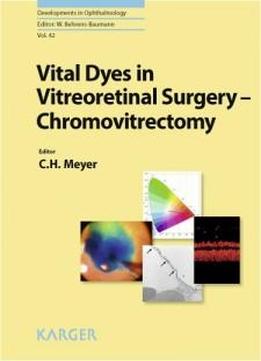
Vital Dyes In Vitreoretinal Surgery: Chromovitrectomy (developments In Ophthalmology)
by Carsten H. Meyer /
2008 / English / PDF
11.7 MB Download
Chromovitrectomy is a novel approach to visualize the vitreous or
retinal surface during vitreoretinal surgery. In recent years, the
widely used indocyanine green (ICG) has made the surgical maneuver
of inner limiting membrane peeling tremendously safer and
efficient. Also, numerous dyes have been applied in experimental
settings with promising or devastating results. This volume
highlights the major clinical and experimental results of currently
used novel vital dyes. The first chapters describe the transparent
structure of the vitreous body and summarize historical
considerations to visualize its structure by optical coherence
tomography, dye injections or autologous cells during surgery and
for diagnostic purposes.The following contributions describe the
advantages and disadvantages of ICG during vitreoretinal surgery
and experimental applications. Alternative approaches by recently
approved vital dyes such as trypan blue, patent blue and brilliant
blue are evaluated in the subsequent chapters. Finally the last few
chapters give an outlook on novel vital dyes, which are currently
under evaluation, as well as alternative enzymatic approaches to
remove the vitreous from the retinal surface. Being a timely update
this publication will be indispensable reading for vitreoretinal
surgeons and ophthalmic researchers.
Chromovitrectomy is a novel approach to visualize the vitreous or
retinal surface during vitreoretinal surgery. In recent years, the
widely used indocyanine green (ICG) has made the surgical maneuver
of inner limiting membrane peeling tremendously safer and
efficient. Also, numerous dyes have been applied in experimental
settings with promising or devastating results. This volume
highlights the major clinical and experimental results of currently
used novel vital dyes. The first chapters describe the transparent
structure of the vitreous body and summarize historical
considerations to visualize its structure by optical coherence
tomography, dye injections or autologous cells during surgery and
for diagnostic purposes.The following contributions describe the
advantages and disadvantages of ICG during vitreoretinal surgery
and experimental applications. Alternative approaches by recently
approved vital dyes such as trypan blue, patent blue and brilliant
blue are evaluated in the subsequent chapters. Finally the last few
chapters give an outlook on novel vital dyes, which are currently
under evaluation, as well as alternative enzymatic approaches to
remove the vitreous from the retinal surface. Being a timely update
this publication will be indispensable reading for vitreoretinal
surgeons and ophthalmic researchers.











